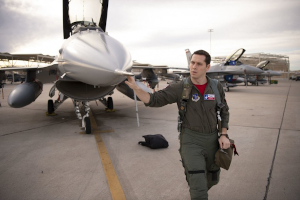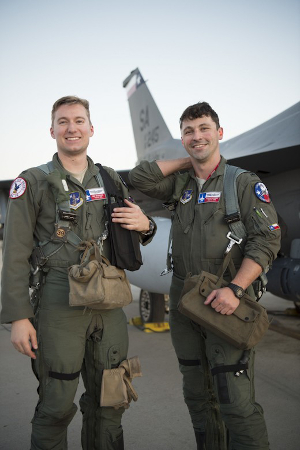Story by Staff Sgt. Derek Davis, 149th Fighter Wing Public Affairs, Texas Air National Guard
LUKE AIR FORCE BASE, Ariz. -- Soon-to-be F-16 pilots, currently assigned to the Texas Air National Guard’s 149th Fighter Wing, arrived in Phoenix Feb 25 to begin Coronet Cactus, the culminating event in their journey to becoming F-16 fighter pilots for the United States Air Force.
 First Lt. James Demkowicz, a student pilot assigned to the 149th Fighter Wing, Texas Air National Guard, conducts preflight checks prior to launch during Coronet Cactus, Feb. 28, 2020, at Luke Air Force Base, Ariz. The annual training event deploys members of the 149th Fighter Wing, headquartered at Joint Base San Antonio-Lackland, Texas, to another environment in order to familiarize them with accomplishing mission objectives in an unfamiliar location. (U.S. Air National Guard photo by Staff Sgt. Derek Davis)
First Lt. James Demkowicz, a student pilot assigned to the 149th Fighter Wing, Texas Air National Guard, conducts preflight checks prior to launch during Coronet Cactus, Feb. 28, 2020, at Luke Air Force Base, Ariz. The annual training event deploys members of the 149th Fighter Wing, headquartered at Joint Base San Antonio-Lackland, Texas, to another environment in order to familiarize them with accomplishing mission objectives in an unfamiliar location. (U.S. Air National Guard photo by Staff Sgt. Derek Davis)
Coronet Cactus is a 14-day training exercise where student pilots fly hundreds of missions, each simulating a different task that they may see later in their Air Force careers.
For many of these fighter pilots-in-training, this exercise brings them even closer to a dream they’ve held since childhood.
“I have always wanted to be a pilot since I was young,” said 1st Lt. Paul Vasta, an F-16 student pilot currently participating in Cactus. “Dad was an Army aviator who got me into aviation. Since then, I have always wanted to fly something fast.”
With more than eight months of intense studying and hundreds of hours of flight time behind them, the students comprising class 19-ABK of the F-16 Initial Qualification Basic Course use Cactus as an opportunity to show their instructors what they’ve learned during their training.
For the instructors, it allows ample time to gauge how the students will perform in an environment that is away from their typical airspace.
“It is a two-week deployment for the basic course students to come out and fly at a different base, in an unfamiliar field, to employ tactics and deploy both heavy and live bombs in different ranges before they graduate," said Lt. Col. Patrick Bridges, one of the course’s instructor pilots assigned to the 149th Fighter Wing.
Bridges has been instructing F-16 students for 16 years now, and his experience tells him that this capstone exercise can cause a little anxiety because the students are not exactly sure what to expect during the event.
 First Lt. Jared Wesemann and 1st Lt. Ian Bonner, two F-16 student pilots assigned to the 149th Fighter Wing, Texas Air National Guard, pose for a photo before take-off during Coronet Bronco, Feb. 24, 2020, at Luke Air Force Base, Ariz. The annual training event deploys members of the 149th Fighter Wing, headquartered at Joint Base San Antonio-Lackland, Texas, to another environment in order to familiarize them with accomplishing mission objectives in an unfamiliar location. (Air National Guard photo by Airman 1st Class Kaliea Green)
First Lt. Jared Wesemann and 1st Lt. Ian Bonner, two F-16 student pilots assigned to the 149th Fighter Wing, Texas Air National Guard, pose for a photo before take-off during Coronet Bronco, Feb. 24, 2020, at Luke Air Force Base, Ariz. The annual training event deploys members of the 149th Fighter Wing, headquartered at Joint Base San Antonio-Lackland, Texas, to another environment in order to familiarize them with accomplishing mission objectives in an unfamiliar location. (Air National Guard photo by Airman 1st Class Kaliea Green)
“We get together on our lessons learned and provide them with a road map to success,” Bridges said. “A successful Cactus is all the students and jets coming back in one piece, and the students getting a taste of what it's like to operate from a different base.”
As Cactus draws to a close, and these students begin to find their rhythm and understand expectations, they cannot help but express hope about that next step in their careers.
"I feel like my dream has been somewhat fulfilled, and it’s exciting to be able to continue to push [myself] and make improvements,” Vasta said. “I will continue flying jets as long as I can and am excited to see what the future brings.”
This article originally appeared on the Air National Guard website.